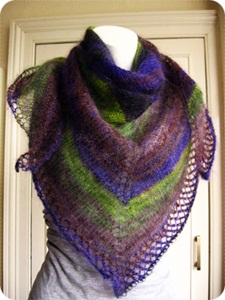 I just released a new free shawl pattern on Ravelry: Alva.
Alva takes one ball of Rowan Kidsilk Haze Stripe (or two balls of regular Kidsilk Haze) and is knitted on 5mm needles. My sample is knitted using sh. 200 ("Twillight").
I just released a new free shawl pattern on Ravelry: Alva.
Alva takes one ball of Rowan Kidsilk Haze Stripe (or two balls of regular Kidsilk Haze) and is knitted on 5mm needles. My sample is knitted using sh. 200 ("Twillight").
I designed Alva because while I love the new KSH yarn, there was a real dearth of patterns available for it. I wanted a simple, straightforward knit which would showcase the colours. Alva is designed for beginning knitters which is why the lace edging is optional (and written out rather than charted). .
I find it is very different to design for yarn support (which I guess Alva is) rather than design for myself. With yarn support, I keep the end user in mind: who would be knitting this pattern? What skill level am I aiming for? How can I make this even easier to knit? I want my design to be accessible to as many people as possible. This is a fun challenge - and actually more than a challenge than it is to design for myself.
My Karise shawl is currently being knitted in a KAL on Ravelry. It was also designed for yarn support, but I took advantage of being able to play around with charts. S. of MooncalfMakes described Karise as having "..a kind of architectural quality to it, like wrought iron-work or granite carvings." I consider this a huge compliment: I find architecture incredibly inspiring and I hope Karise would have a certain sense of stillness to its lace. It is possibly the closest I have come to designing anything for myself.
I look around Ravelry and I see increasingly complicated lace shawls being showcased. In my own quiet way I guess I'm reacting against that trend. I just don't get it. I do not want to wear things that have 1001 details. I would feel overwhelmed, drowning in frills and bobbles and twisted stitches. I would much rather wear a carefully edited shawl, something understated, something knowing. Maybe it is the Scandinavian in me, maybe it is because I like sparseness in most things.
And William Carlos Williams and his This Is Just To Say was just as difficult to write as, say, Ezra Pound's Cantos (if not more), this liberal arts grad girl would like to point out.
On a whole other note, Fourth Edition is being moved about in the next few weeks. Stay tuned for disruption (unless I manage to work things out quickly).
PS. 'Tis now the season for CRAP light so until April, expect bad photos.



 US terminology:
Row 1: Ch 8, slip stitch to form circle, ch 2, turn.
Row 2: 5 dc into circle, ch 4, 1 sc into circle, ch 2, turn.
Row 3: 5 dc into the circle you formed in previous row, ch 4, 1 sc into circle, ch 2, turn.
US terminology:
Row 1: Ch 8, slip stitch to form circle, ch 2, turn.
Row 2: 5 dc into circle, ch 4, 1 sc into circle, ch 2, turn.
Row 3: 5 dc into the circle you formed in previous row, ch 4, 1 sc into circle, ch 2, turn.